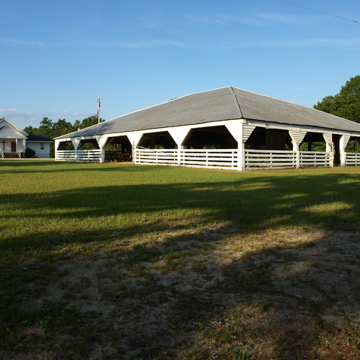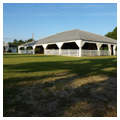You are here
Little Texas Tabernacle
The Great Awakening stimulated religious activity across the United States. In the early nineteenth century, Protestant camp meetings proliferated, especially on the frontier, where scattered rural settlers rarely congregated in substantial numbers except for trade. Presbyterians, Baptists, and Methodists all participated in the campground phenomenon but the Methodists embraced it with particular ardor. During the nineteenth century there were 35 Methodist campgrounds in Alabama, of which the campground at Little Texas is one of two remaining. Established in 1838 between Tuskegee and Auburn in east central Alabama, Little Texas is Alabama’s oldest extant open-air sanctuary, or tabernacle.
The Tabernacle is located in what today remains a small farming community near the Federal Road that brought pioneer settlers into the state from Georgia after the Creek War of 1813–1814 and the Second Creek War of 1836. (According to local lore, Little Texas got its name from a group that stopped well short of its original destination west of the Mississippi.) Here as elsewhere, tabernacles served as the centerpiece of camp meetings, evolving from brush arbors and preachers’ stands that elevated speakers and provided protection from sun and rain. They were typically surrounded by tents, rustic accommodations of fabric or wood assembled by worshippers who camped in them for a week or more during mid-summer revivals and reunions.
The Little Texas Tabernacle is an extraordinary heavy-timber construction whose expansive hip-and-ridge roof shelters a spacious yet intimate interior that is still surrounded by wooden railings and gates to keep cattle out between services. According to local historian Alexander Nunn, the massive, braced-frame structure was built by a prominent member of the Auburn Methodist Church, Isaac Hill, along with slave labor, so the unknown construction date must have occurred prior to the Civil War, probably in the 1850s, concurrent with construction of substantial churches in nearby Tuskegee and Auburn.
The bottoms of the support posts have been replaced with concrete (probably in the mid-twentieth century), but the framing and roof joists are original, as is the roof decking of broad, thick, straight-sawn, random-width, rough-edged, heart pine boards. When the shake shingles were removed long ago, the square nails that held them were hammered through the roof decking (where they remain), and sheet metal barn roofing was eventually installed.
The tabernacle still has a sawdust floor, which is renewed annually. The supports for the pews were replaced at some point, but most of the pew backs and broad, single-board seats appear original. Many have square holes where cut nails were removed when the replacement supports were installed with wire nails. The pews are connected at their bases with wooden rails; typical of tabernacle seating, the space between the rails is covered in sawdust.
An electrical feed has been introduced discretely below grade, with the fuse box screened by the apron covering a corner post’s angle braces. Lights of various vintages and a few ceiling fans have also been installed. The latter provide modest comfort for church members and visitors who use the tabernacle not only for annual homecomings, but throughout the year for weddings, ice cream socials, gospel sings, and other church events.
No tents survive at Little Texas (unlike at the other extant campground in Ethelsville), but a wood frame “commissary,” now used for storage, and three metal-roofed, gabled sheds used for church dinners stand near the tabernacle. All are built with late-twentieth-century materials and techniques. The three sheds with their distinctive buffet tables are among the best in the South for dinner on the grounds. They appear to be repurposed precast reinforced concrete building components set on poured concrete supports. The trim and neat cemetery that lies across the road contains many graves, some still regularly swept, of those who frequented this special place prior to the Civil War.
The tabernacle and its support buildings stand adjacent to the Williams Chapel United Methodist Church, a tidy, undated sanctuary that was built with mortise and tenon. Later additions, a Christian education east wing and a recent west-wing fellowship hall, frame the simple but stately central pavilion, the proportions of which are typical of vernacular Greek Revival churches in the South. The church is a good steward of its facilities and boasts an energetic rural congregation.
References
Lipscomb, Carolyn Ellis. Auburn United Methodist Church, 1837–1987. Auburn, AL: n.p., 1987.
Nunn, Alexander. Yesterdays in Loachapoka and Communities Nearby. Loachapoka, AL: Homecoming Association, 1968.
Panhorst, Michael W. “The Tabernacle: Centerpiece of Alabama’s Early Camp Meetings.” Alabama Heritageno. 115 (Winter 2015): 4-6.
Pearson, Ann. “Tabernacle in Little Texas: Annual Church Homecomings Have Met for Nearly 150 Years.” Opelika-Auburn News, c. 2000.
Writing Credits
If SAH Archipedia has been useful to you, please consider supporting it.
SAH Archipedia tells the story of the United States through its buildings, landscapes, and cities. This freely available resource empowers the public with authoritative knowledge that deepens their understanding and appreciation of the built environment. But the Society of Architectural Historians, which created SAH Archipedia with University of Virginia Press, needs your support to maintain the high-caliber research, writing, photography, cartography, editing, design, and programming that make SAH Archipedia a trusted online resource available to all who value the history of place, heritage tourism, and learning.











